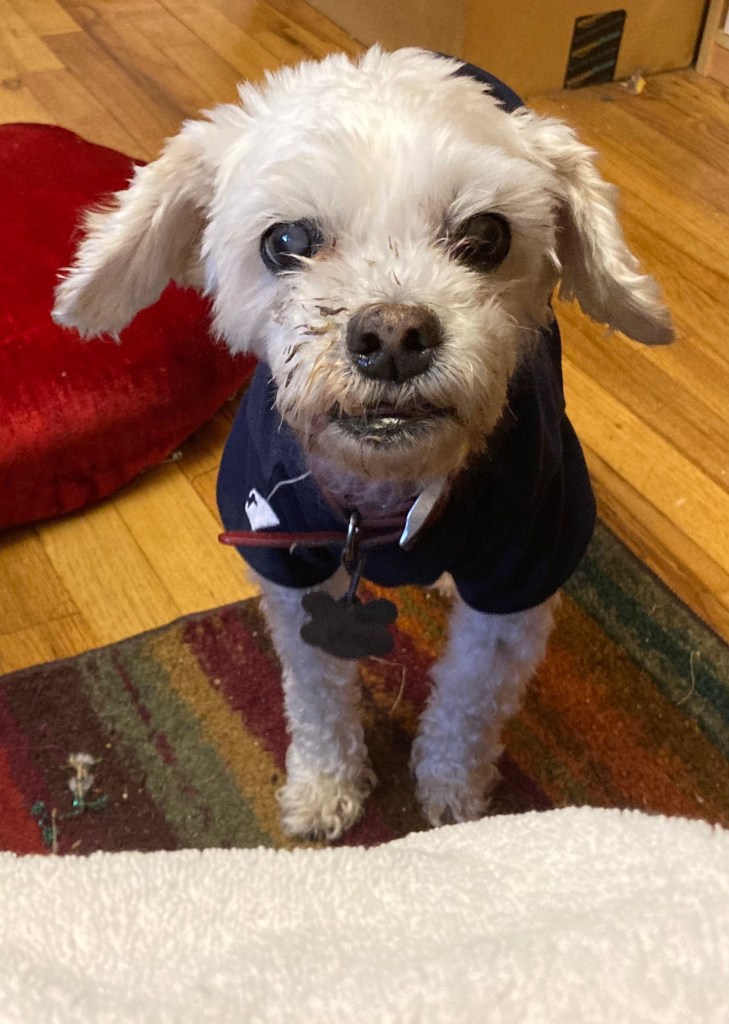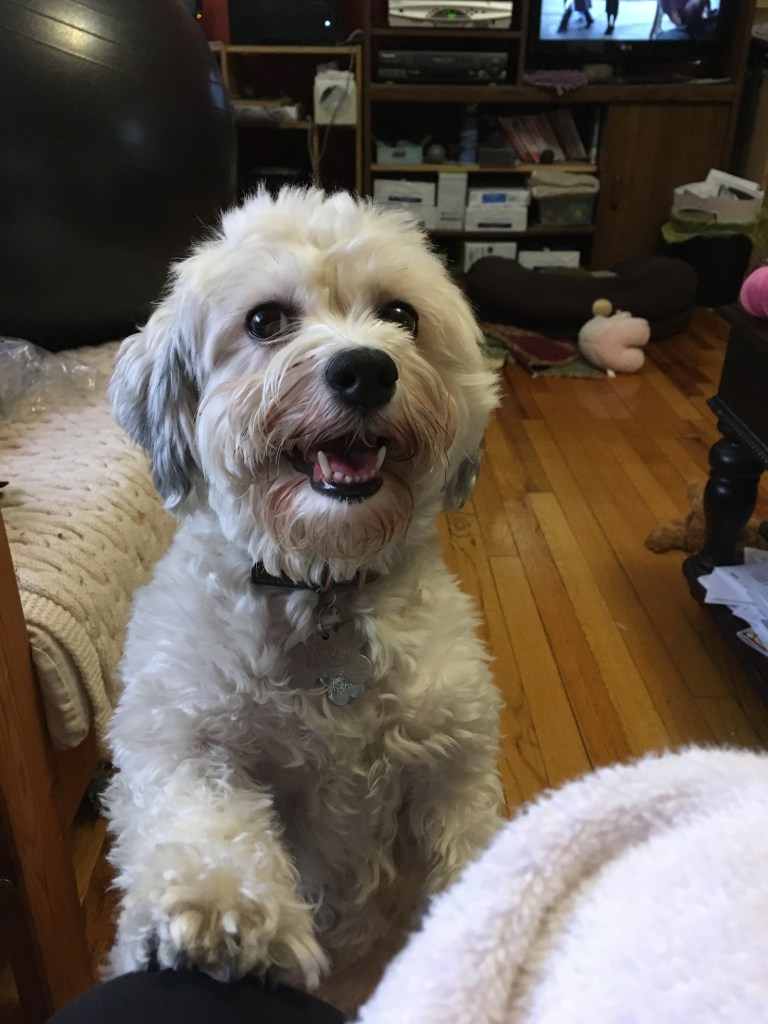In the midst of Cricket’s terminal illness, we were also dealing with very bad news about Ellie’s heart: it was two times the size it should have been, and surrounded by fluid that shouldn’t be there. She would need to take four new medications, twice a day, and we’d need to find a diet for her that was both low in sodium and tasty enough to get her to take all of her meds. But it just didn’t seem possible to me that Ellie could be so sick, not while Cricket was busy dying.
A week before Cricket’s death, we took Ellie back to the vet, because she had been coughing more than usual and we wanted to make sure we were doing everything possible to keep her with us. A new x-ray showed that her heart was still twice the normal size, and that there was still some fluid around it, so the vet raised the dose of her diuretic and told us to come back in two weeks for a blood test. The coughing stopped for a few days, but after Cricket’s death Ellie had more of the fainting attacks that had sent us to the vet in the first place, months earlier, losing control over her legs and flopping down on her chest.
In the car on the way to the vet for the follow up blood test, Ellie was even more nervous and agitated than usual, and we wondered if she was thinking of Cricket, and how Cricket hadn’t come home from her last trip to the vet. Standing in the same examination room where Cricket had taken her last breath, the vet took Ellie’s blood and suggested another echo sometime soon, to see if issues had progressed into her lungs. I had a whole list, at home, of questions I’d planned to ask and medication refill requests, but I couldn’t remember any of it. Eventually, because she was giving me her sad puppy eyes, I remembered to tell the vet that Ellie had become a very picky eater recently, wanting only the special foods (chicken treats, greenies, chicken liver, fresh cooked chicken) instead of the well-rounded, low-sodium diet we were trying to give her. And the vet turned back from the computer screen, where he’d been updating her chart, and said “treat her like a make-a-wish kid, and give her anything she wants.”
I didn’t curse at him, out loud. I just stood there, forgetting to ask for the refills or anything else. He recommended a brand of healthy treats from the pet supply store next door that might help Ellie eat her good-for-her food, and then we paid our latest bill and went next door for the treats and then went home, to Ellie’s great relief.
The new treats went over well enough, though Ellie now believes she should be hand fed each meal. And then, within a few days of her vet visit we noticed blood spots on her wee wee pad and I freaked out. We had to follow her around with a ladle to get a pee sample, but in a few days we found out that she had a urinary tract infection, which was much better than the ten other imaginary diagnoses that were spinning around in my head. The vet put her on anti-biotics, which made her even more exhausted at first, but eventually started to make her feel better.
In the middle of worrying about Ellie, and grieving over Cricket, we had a moment of joy. Out of nowhere one night, despite still refusing to eat her regular food, Ellie begged for some of Mom’s dinner, a piece of red pepper, a few pieces of broccoli, and then pumpkin bread, all foods that Ellie generally ignored, but Cricket had always loved. Maybe she was just craving something different because of her illness, but it seemed to us like she was channeling her sister and bringing her back to us for a moment.
Ellie still looks for her sister around every corner, almost as if she expects Cricket to pull a “Gotcha” on her at any moment, and I look for Cricket too, imagining that she’s just sleeping and that’s why the apartment is so quiet. I’m still in the numb phase of grief, unable to take it in for more than a few minutes at a time. And, in the midst of that grief, I just can’t think of Ellie as having only another six months to a year, which is what the vet predicted when he first told us about her heart, months ago now. I like to tell myself that the vet never expected Cricket to live as long, or as well, as she did, so what does he know? Except, Ellie isn’t Cricket. Ellie had to use up a lot of her spirit surviving her first four and a half years as a breeding mama, and I can’t expect her to fight for more time the way Cricket did. Instead, I want God, or the universe, or veterinary medicine to intervene and give her the extra years she deserves; and I’m pissed off, beyond words, that that probably won’t happen.
But for now, we still have Ellie with us, and she’s recovering from her UTI and getting some bounce back in her step, and asking for cuddles and treats and looking askance at our continued attempts to feed her the “healthy” food.
It’s cruel that my sweet, loving, almost nine-year-old Ellie is going to die too soon, from an oversized heart, of all things. Butterfly, Cricket’s first rescue sister, had the same heart issues (along with a few others, caused mainly by her eight years as a breeding dog at a puppy mill), and the same sweetness as Ellie, and she lived to almost thirteen years of age despite all of it. But the vet says Ellie’s heart disease is more serious and more advanced and there’s nothing we can do, other than what we are already doing. I know he means well and wants us to be prepared, but right now the thing I want most in the world is for the doctor to be wrong.
If you haven’t had a chance yet, please check out my Young Adult novel, Yeshiva Girl, on Amazon. And if you feel called to write a review of the book, on Amazon, or anywhere else, I’d be honored.
Yeshiva Girl is about a Jewish teenager on Long Island, named Isabel, though her father calls her Jezebel. Her father has been accused of inappropriate sexual behavior with one of his students, which he denies, but Izzy implicitly believes it’s true. As a result of his problems, her father sends her to a co-ed Orthodox yeshiva for tenth grade, out of the blue, and Izzy and her mother can’t figure out how to prevent it. At Yeshiva, though, Izzy finds that religious people are much more complicated than she had expected. Some, like her father, may use religion as a place to hide, but others search for and find comfort, and community, and even enlightenment. The question is, what will Izzy find?












